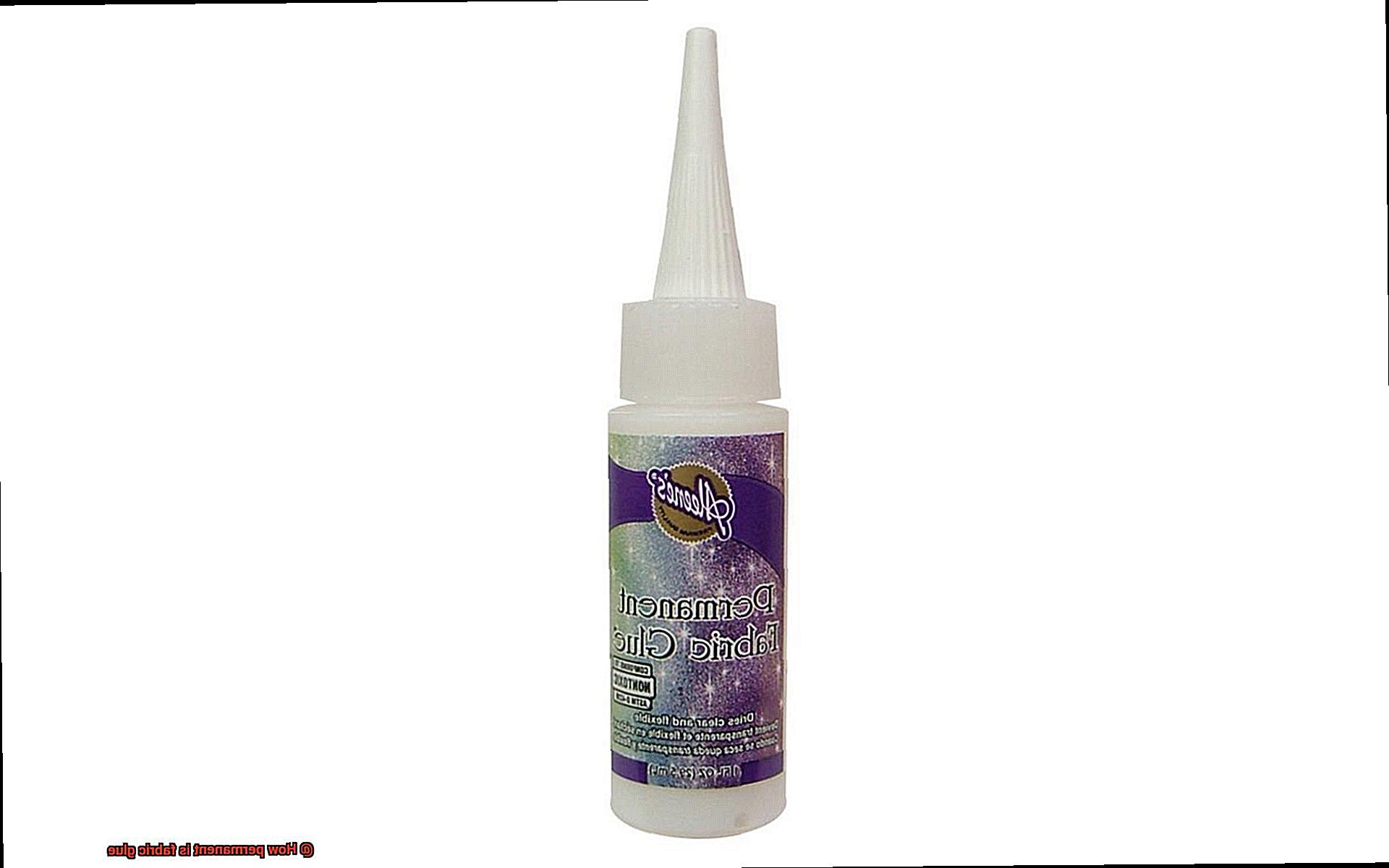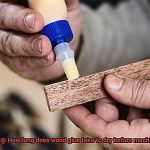Sick of your clothes unraveling like a cheap sweater?
Desperate for a way to stitch fabrics together without the hassle of needles and thread? Look no further, my friend, because fabric glue might just be the answer to all your textile troubles.
This magical adhesive is like a superhero cape for your DIY projects, rescuing torn garments and unleashing your creativity with its no-sew powers. But here’s the million-dollar question: how permanent is fabric glue, really?
Brace yourself for a wild ride through washes, wears, and the mysterious factors that determine whether this adhesive will stick around or disappear like Houdini on laundry day.
How Permanent is Fabric Glue?
Contents
- 1 How Permanent is Fabric Glue?
- 2 Factors Affecting the Permanence of Fabric Glue
- 3 The Bond between Different Fabrics
- 4 Stretching or Pulling on the Bonded Area
- 5 Exposure to Extreme Temperatures
- 6 Exposure to Chemicals and Solvents
- 7 Choosing the Right Type of Glue
- 8 Care and Maintenance for Long-Lasting Bonds
- 9 Conclusion
Fabric glue has taken the crafting world by storm, offering a convenient alternative to traditional sewing and stitching. But just how permanent is fabric glue? In this article, we will dive into the fascinating world of fabric glue and explore the factors that influence its permanence. Get ready to unlock valuable insights that will help you make informed decisions for your crafting projects.
Factors Affecting Permanence:
Type of Fabric:
The fabric you’re working with can make or break the permanence of your fabric glue bond. Smooth surfaces like cotton or polyester are ideal, providing an optimal surface for the glue to adhere to. However, rough or textured fabrics may not bond as effectively, resulting in a less permanent hold.
Quality Matters:
Not all fabric glues are created equal. The quality of the adhesive used can have a significant impact on its permanence. Look for high-quality fabric glues labeled as “permanent” or “washable.” These specially formulated glues are designed to withstand repeated washing and drying cycles without compromising their adhesive properties.
Masterful Application:

Proper application is key to achieving a strong and permanent bond with fabric glue. Follow the manufacturer’s instructions diligently, ensuring an even distribution of the glue and allowing it ample time to dry before handling or washing. Attention to detail in these crucial steps can greatly enhance the longevity of your bond.
Environmental Factors:

Consider the environment in which your glued item will be exposed. Extreme temperatures or exposure to harsh chemicals and solvents can weaken or degrade the adhesive over time. To combat these challenges, opt for a fabric glue specifically designed to withstand such conditions.
Factors Affecting the Permanence of Fabric Glue
Today, we’re diving deep into the factors that can affect the permanence of fabric glue. So grab your glue guns and let’s explore.
First and foremost, let’s talk about the type of fabric. Different fabrics have different textures and compositions, which can directly impact how well the glue adheres to them. Porous fabrics like cotton or linen eagerly absorb glue, creating strong bonds that can withstand repeated use and washing. On the other hand, synthetic fabrics such as polyester or nylon may require a specific type of fabric glue formulated to bond with their unique composition.
Next up, the quality of the glue itself plays a crucial role in its permanence. Higher-quality glues often contain stronger bonding agents that ensure better adhesion to fabric fibers. These premium glues are specially designed to withstand washing, heat, and other stresses that fabrics may encounter. So investing in a top-notch glue can mean the difference between a project that holds up for years versus one that falls apart after just a few uses.
Now let’s talk technique. The way you apply fabric glue can make or break its permanence. It’s essential to follow the manufacturer’s instructions precisely and apply the glue evenly and generously on both surfaces being bonded. Insufficient or uneven application can lead to weak adhesion and decreased durability.
But it doesn’t stop there. Drying and curing time also play an important role in the permanence of fabric glue. After applying the glue, it needs ample time to dry before joining the glued surfaces together. Drying times can vary depending on the specific glue used, ranging from mere minutes to several hours. And don’t forget about curing time. Some glues require additional time for the bond to strengthen and become more permanent.
Lastly, environmental factors can impact the permanence of fabric glue. Extreme temperatures, high humidity levels, exposure to sunlight or moisture – all these factors can weaken the adhesive properties of the glue over time. So be mindful of where you store your glue and try to keep it in a cool, dry place away from direct sunlight.
So there you have it, crafters. By considering these factors – type of fabric, quality of glue, application technique, drying and curing time, and environmental conditions – you can ensure a more permanent bond with your fabric glue. With this knowledge in hand, you can confidently tackle those fabric projects, knowing that your glue will hold strong for years to come.
The Bond between Different Fabrics
The bond between different fabrics is a fascinating topic to explore, especially when using fabric glue. Fabric glue offers a versatile and convenient way to bond various types of fabrics together, but understanding the intricacies of this bond is crucial for successful projects. Let’s delve into the key factors that contribute to the strength and durability of the bond between different fabrics.
Types of Fabrics:
Certain fabrics exhibit excellent adhesion properties with fabric glue, such as cotton, linen, and polyester. These materials form strong bonds that withstand the test of time. However, delicate fabrics like silk or chiffon require extra caution due to their lightweight nature. Strong adhesives can easily damage these fabrics, so it’s essential to perform a patch test before applying fabric glue on the entire piece.
Surface Texture:
Synthetic fabrics like nylon or polyester blends often have smooth surfaces that pose a challenge for fabric glue adhesion. A simple solution is to gently roughen up the fabric’s surface using sandpaper or a fine-grit emery board. This creates tiny grooves on the fabric, enhancing the bond with fabric glue.
Washing and Care Instructions:
To maintain a long-lasting bond, it’s crucial to follow both the fabric’s and fabric glue manufacturer’s recommendations for washing and care. Some fabrics require specific handling or detergents that may weaken or break down the adhesive over time. By adhering to these instructions, you can ensure the bond remains intact even after multiple washes.
Environmental Factors:
Extreme temperatures and high humidity levels can compromise the adhesive’s strength, leading to a weakened bond between fabrics. Storing fabric-glued items in cool and dry conditions helps maintain the integrity of the bond and ensures longevity.
Stretching or Pulling on the Bonded Area
In this article, we will delve into the world of fabric glue and explore its durability in the face of tension. Whether you’re a DIY enthusiast or simply curious about fabric glue, read on to discover valuable insights that will help you understand its strength.
Understanding the Importance of Stretching and Pulling:
Fabrics endure constant tension and stress during regular use and laundering. Therefore, it’s crucial to know how fabric glue withstands stretching or pulling on the bonded area. This factor determines the bond’s longevity and overall quality of your project.

The Stretch Test:
Manufacturers often conduct a stretch test to evaluate fabric glue’s durability. During this test, a piece of fabric bonded with the glue undergoes controlled stretching or pulling. By observing how well the glue holds up under tension, experts can assess its ability to maintain a secure bond even when significant force is applied.
Factors Affecting Durability:
Several factors influence fabric glue’s durability when stretched or pulled. The type of fabric being bonded plays a significant role, as some fabrics are more elastic or prone to stretching than others. Additionally, the application method used and the drying time allowed before subjecting the bond to tension can impact its strength.
Excessive Force and Limitations:
While fabric glues can provide reliable bonds under normal circumstances, it’s important to exercise caution and avoid subjecting fabrics to unnecessary strain. Excessive force can damage fabric fibers, leading to tearing or fraying, regardless of the adhesive used. Striking a balance between bond strength and the fabric’s structural integrity is crucial.
Exposure to Extreme Temperatures
Let’s dive in and explore the fascinating relationship between fabric glue and extreme temperatures.
When the temperature rises, fabric glue can become as temperamental as your auntie during a heatwave. As the mercury climbs, the adhesive can turn runny or sticky, compromising its ability to hold fabrics together. Imagine your favorite summer dress slowly falling apart while you sashay under the scorching sun – not exactly the look you were going for, right?
On the flip side, freezing temperatures can put a chill on fabric glue’s performance. When exposed to extreme cold, the adhesive becomes brittle and loses its elasticity. Picture your carefully glued winter mittens snapping apart like delicate icicles – definitely not what you had in mind for cozy warmth.
To avoid these sticky situations, it’s essential to choose high-quality fabric glue specifically designed to withstand temperature fluctuations. Look for glues that boast added ingredients for enhanced resistance to both heat and cold. Many manufacturers provide recommended temperature ranges for their products, so be sure to check those instructions before diving into your craft project.
Another pro-tip is to apply fabric glue in multiple thin layers rather than one thick glob. This allows for better distribution of the adhesive, creating a stronger bond. And don’t forget about drying and curing times. Following the manufacturer’s guidelines ensures your glue has enough time to set properly and creates a bond that can brave extreme conditions.
So whether you’re creating a breezy summer wardrobe or cozy winter accessories, understanding how extreme temperatures affect fabric glue is key to achieving long-lasting results. Remember to choose the right glue for the job, apply it in thin layers, and give it ample time to dry and cure.
Exposure to Chemicals and Solvents
Exposure to chemicals and solvents can pose serious health risks. It’s crucial to understand the potential dangers associated with these substances to protect ourselves and make informed decisions.
One of the primary concerns is the weakening or dissolution of fabric glue over time. Picture this: you’ve spent hours creating a beautiful piece, only to have it fall apart due to exposure to harsh cleaning agents or solvents. It’s a nightmare. To prevent such disasters, keep your glued fabrics far away from these destructive substances.
But that’s not all – chemicals can also wreak havoc on the appearance of your fabrics. Who wants their delicate or light-colored fabrics discolored or stained because of a reaction with fabric glue? Nobody. So, be wise in your glue selection and test it on a small, inconspicuous area before diving into your project.
Now, let’s talk safety. Fabric glue contains various chemical compounds that can be harmful if inhaled or ingested. To play it safe, always use it in well-ventilated areas. Oh, and don’t forget those gloves. We want your skin intact while you unleash your creativity.
As if that wasn’t enough, exposure to chemicals and solvents can also impact fabric quality. Different fabrics may react differently, leading to changes in texture or stiffness. No one wants their fabulous creation feeling like cardboard, right?
To ensure the permanence of your fabric glue, follow these tips: avoid harsh chemical cleaners and solvents; opt for gentle cleaning methods; store glued fabrics in a cool, dry place away from direct sunlight; and carefully follow the manufacturer’s instructions. These simple steps will go a long way in ensuring a strong and lasting bond between your fabrics.
In conclusion, exposure to chemicals and solvents presents notable health risks. It can weaken fabric glue, damage fabric appearance, pose safety hazards, and compromise fabric quality. By taking precautions, such as avoiding damaging substances, using proper ventilation, and following guidelines, you can protect your health and create long-lasting glued fabric masterpieces.
Choosing the Right Type of Glue
When it comes to choosing the right type of glue for your fabric projects, there are several factors to consider. First and foremost, think about the type of fabric you’re working with. Delicate or lightweight fabrics like silk or chiffon require glues that are specially designed for these materials. You’ll want to look for lightweight and non-staining options to ensure your fabric stays pristine.

On the other hand, if you’re working with heavier fabrics like denim or canvas, a stronger adhesive is needed. These fabrics can put some serious stress on the bond, so opt for a fabric glue with a stronger bond strength to keep everything in place.
Next, think about the intended use of your fabric. If you need a permanent bond, go for a glue specifically designed for permanent adhesion. These glues have a stronger bond and may require heat or pressure to fully activate.
However, if you’re looking for a temporary bond or need to reposition the fabric during the gluing process, a temporary fabric glue is your best bet. These glues allow for easy repositioning and can be removed without leaving any residue or damaging the fabric.
Don’t forget about additional properties or features that may be required for your project. If your fabric will be exposed to water or outdoor elements, opt for a waterproof or weather-resistant fabric glue. And if you need quick drying times or flexible bonds that allow your fabric to move freely, there are glues out there with those special features.
Lastly, always perform a small test on an inconspicuous area of your fabric before applying glue to the entire project. This will help ensure that the glue adheres properly and doesn’t cause any damage or discoloration.
Care and Maintenance for Long-Lasting Bonds
Look no further. In this article, we will explore the importance of proper care and maintenance for long-lasting bonds created with fabric glue. Whether you’re a seasoned craftsperson or just starting out, these tips will help you achieve professional-quality results that will endure.
Follow the Manufacturer’s Instructions:
First and foremost, always adhere to the manufacturer’s instructions when using fabric glue. Different glues may have specific care guidelines, so take the time to read and understand them thoroughly. This ensures that you are using the glue correctly and following the necessary steps to maintain a strong bond.
Allow Ample Drying Time:
Patience is key when it comes to fabric glue. After applying the glue and joining the fabrics together, it is crucial to let them dry completely before applying any stress or strain. Rushing this process can weaken the bond, leading to premature failure. So sit back, relax, and give your project the time it needs to set.
Wait Before Washing:
While you may be eager to showcase your newly bonded fabrics, resist the temptation to wash them too soon. Most fabric glues require a waiting period before they become fully washable. Washing too early can disrupt the bond and cause it to loosen or break. Check the manufacturer’s instructions for specific guidance on washing and drying times.
Gentle Washing Is Key:
When it’s finally time to wash your bonded fabrics, remember to use gentle cycles or hand wash them. Harsh washing cycles can stress the bond excessively, weakening it over time. Opt for mild detergents that do not contain harsh chemicals, as they can preserve the bond’s integrity.
Protect from Heat and Sunlight:
To keep your bonded fabrics in top shape, avoid exposing them to extreme heat or direct sunlight for extended periods. High temperatures can soften the glue and compromise its adhesive properties. Prolonged sunlight exposure can cause fabric colors to fade, weakening the bond over time. Store or display your creations in cool, shaded areas to protect them.
Regularly Inspect and Repair:
Make it a habit to inspect the bonded area regularly for signs of wear or damage. Normal wear and tear, as well as other factors, can weaken the bond over time. If you notice loose threads, fraying edges, or compromised areas, take prompt action to repair or reinforce them. This maintenance helps maintain the bond’s longevity and prevents further damage.
CpMhRyabggI” >
Conclusion
In conclusion, fabric glue offers a convenient and effective alternative to traditional sewing and stitching. However, its permanence is influenced by various factors.
The type of fabric you’re working with is critical. Smooth surfaces like cotton or polyester are perfect for fabric glue, while rough or textured fabrics may not bond as effectively. Additionally, the quality of the adhesive used plays a significant role in determining its durability. Look for high-quality fabric glues labeled as “permanent” or “washable” to ensure a lasting bond.
Proper application is key to achieving a strong and permanent connection with fabric glue. Follow the manufacturer’s instructions diligently, ensuring even distribution and ample drying time. Environmental factors such as extreme temperatures or exposure to harsh chemicals can also impact the longevity of fabric glue, so opt for a glue specifically designed to withstand these conditions.
When bonding different fabrics together, consider their composition and surface texture. Some fabrics bond more effectively than others, and roughening up smooth surfaces can enhance adhesion. It’s also crucial to follow washing and care instructions for both the fabric and the fabric glue.
Stretching or pulling on bonded areas can affect the bond’s longevity. While fabric glues can provide reliable bonds under normal circumstances, excessive force can damage fabric fibers regardless of the adhesive used.
Exposure to extreme temperatures or chemicals and solvents can weaken or dissolve fabric glue over time. Choose glues designed to withstand temperature fluctuations and avoid exposing glued fabrics to damaging substances.
Choosing the right type of glue for your project is essential. Consider the type of fabric, intended use, additional properties needed (such as waterproofing), and perform a small test before applying glue extensively.
To maintain long-lasting bonds created with fabric glue, diligently adhere to manufacturer’s instructions, allow ample drying time, refrain from washing too soon, use gentle washing methods, protect from heat and sunlight, regularly inspect for any damage that needs repair.
By considering these factors and taking proper care and maintenance steps, you can ensure a more permanent bond with your fabric glue and create projects that withstand the test of time.






